Update on PCAST Report on Federal Spectrum & Sharing
Video streaming by Ustream
On Friday, April 4, New American Foundation hosted a distinguished set of speakers on the PCAST spectrum report, including several of its authors. Here is a list of speakers:
- Jason Furman - Chair, President’s Council of Economic Advisors
- Tom Power - Deputy CTO for Telecommunications, White House Office on Science and Technology Policy
- John Leibovitz - Deputy Bureau Chief, Wireless Telecommunications Bureau and Spectrum Advisor to the Chairman, FCC
- Craig Mundie - Member, President’s Council of Advisors on Science and Technology (PCAST) and Senior Advisor to the CEO, Microsoft Corporation
- Mark Gorenberg - Member, President’s Council of Advisors on Science and Technology (PCAST) and Founder and Managing Director, Zetta Venture Partners
- Milo Medin - Vice President of Access Services, Google Inc., and Invited Expert, PCAST
Above is the video of the event. Of particular interest is the talk by Tom Power on implementation of PCAST (00:06:30 - 00:26:00) and an excellent talk by Jason Furman of the economic importance to getting spectrum policy right - a topic rarely discussed. (0:26:34 - 00:53:00).
Your blogger is humbled by the kind words of PCAST member Mark Gorenberg at 01:18:40.
DoD Electromagnetic Spectrum Strategy Release
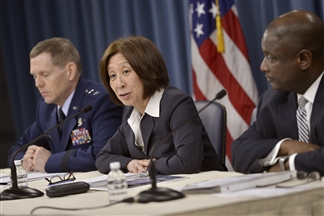
Teri Takai, center, the Defense Department's chief information officer, Air Force Maj. Gen. Robert E. Wheeler, left, the department's deputy chief information officer, and Frederick J. Moorefield Jr., right, the department's director of spectrum policy and programs, brief reporters on the department's release of its electromagnetic spectrum strategy. DOD photo by Glenn Fawcett .
On Thursday February 20, 2014 “The Department of Defense announced … the release of its Electromagnetic Spectrum Strategy (EMS) to increase available spectrum in order to meet growing demand from the commercial wireless industry while maintaining critical military capabilities.” CTIA responded almost immediately with this statement from Steve Largent:
“We agree with the DoD's conclusion that its systems must become more spectrally efficient, flexible and adaptable. In fact, these are good goals for all federal users, and CTIA looks forward to engaging with the DoD, NTIA and the whole federal user community to see how the wireless industry can help them achieve their mission objectives while ensuring that commercial users have access to the spectrum our members need to meet consumer demand and drive economic growth and innovation.”
The first thing we noticed, sort of the “elephant in the room”, was that the report that was released was dated “SEP 11 2013”:
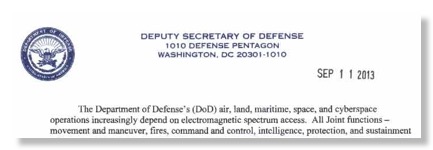
and was actually titled “Electromagnetic Spectrum Strategy 2013 - A Call to Action”. Why this 2013 report was released more than 3 months after it was signed and dated in an unclassified form is a mystery not mentioned in any trade press coverage. Our best guess was that there are a behind the scenes disagreement somewhere within in the Executive Branch or between FCC and NTIA. CTIA’s prompt response indicates that they were not waiting for the report to appear on the DoD website.
The following diagram from the report shows that DoD has a better handle on quantifying its needs than CTIA does with its famous “flag chart”: DoD quantifies its mobile communications needs in terms of “Mbps per 5000 Military Members” and shows how this has increase dramatically and will continue to do so. The cellular industry, by contrast, denominates its requirements solely in terms of MHz, independent of technical developments and the gains due to infrastructure growth/cell splitting. Now presumably the industry projection included expected gains from technical efficiency improvements and infrastructure growth, but these are never itemized nor are they updated. For example, due to the availability of new technology in the past 3 years, has the spectrum requirements in the “flag chart” increased or decreased? The real requirement for both DoD and the cellular industry is really denominated in data rate as DoD has done in this report. Kudos to DoD.
Getting to the actual report, it fully supports the reallocations ordered by President Obama in June 2010 to get 500 MHz of new spectrum to cellular carriers from existing federal and non-federal spectrum. No great surprise.
A key section says:
DoD systems must become more spectrally efficient, flexible, and adaptable, and DoD spectrum operations must become more agile in their ability to access spectrum in order to increase the options available to mission planners. (Spectrum efficiency is the use of the minimum amount of EMS resources necessary to ensure maximum operational effectiveness in fully accomplishing the required mission while taking all practicable steps to minimize impacts to other systems in the EME.Spectrum flexibility and adaptability is the capability of a spectrum-dependent system (SDS) to exploit various opportunities to access spectrum – e.g., multi-band operation, increasing the ability to share spectrum with other systems (domestic or foreign, federal, or non-federal), becoming more tolerant of interference. Agile spectrum operations will enable DoD systems to utilize their flexibility and adaptability to achieve mission success in rapidly changing EMEs.)
In the past, spectrum was a “free good” (except for minor NTIA regulatory fees) for DoD and other federal users and there was no incentive to be efficient as long as enough spectrum was obtainable. Top level attention to spectrum efficiency is thus a good move in the right direction and hopefully NTIA will extend this to other agencies. But the focus in this discussion is making military systems more agile so they can access more bands as they operate around the world.
What is missing is what NTIA Chief Larry Stickling said a few months ago, “sharing is the new normal”. While DoD is implementing White House orders to make spectrum available for the politically (and economically) powerful cellular industry, will DoD be more receptive to sharing proposals in other bands and be less likely to automatically stonewall? We have repeatedly pointed out that 225-400 MHz military use generally is very different geographically than civil use (San Diego being a notable exception) and that with new technology it could be made available to civil users on an “interruptible spectrum” basis, not unlike what is being considered for the 3550-3650 MHz band. Will DoD be receptive to such creative sharing proposals? We hope so but the new policy statement is silent on the issue.
We hope DoD and NTIA will clarify the issue of what is meant by “sharing is the new normal” and specifically whether this is a one way street with respect to military spectrum use in US territory.

Will spectrum sharing in US territory be a one way street for DoD?
UPDATE
See http://www.marcus-spectrum.com/Blog/files/SpecMeasCorr414.html
Sharing Federal Spectrum - New Report

Of particular interest to your blogger was Section VII. Facilitating Sharing: Incentivizing Federal Users. Federal users currently pay a small fee that supports the costs of the NTIA spectrum office. But the fee structure is not well known and is about $150/NTIA assignment. An assignment might be a 25 kHz channel in one city, a communications satellite, or a nationwide system. The fee is the same as NTIA has never been able to work out with the IRAC a better system.
Here is the description of Section VII from the executive summary of the report:
It is widely accepted that until Federal users internalize the costs associated with their spectrum use, they have little incentive to use spectrum more efficiently or support proposals to share their spectrum. If federal users paid for spectrums use, they would internalize the cost associated with holding spectrum assignments that prevent other productive uses of the frequencies.
Recognizing the costs of spectrum through a federal fee would incentivize federal users to adjust their usage to reduce costs. While there are limitations to a fee-based approach, it would require government users to incur some cost for spectrumusage. By imposing a spectrum based fee, the cost of spectrum based services for federal users will reflect the use of this scarce resource. The question is: what should the fee be tied to?
Consistent with the principle that government spectrum users should consider the forgone economic value of spectrum deployed for their services, we suggest that a federal user fee should be based on the commercial value of spectrum. By tying the fee for federal spectrum to spectrum’s commercial price, federal users would be incurring the foregone economic value or opportunity cost of the spectrum in deploying these federal services. A fee based on the commercial value of spectrum would require that federal users at least acknowledge this opportunity cost of the spectrum use and publicly argue that the value of their use of the spectrum exceeds this opportunity cost.
Busy Day in Federal Spectrum Management

Among the findings:
- Since 2009, the percentage of American homes reached by high-speed broadband networks have more than quadrupled (from less than 20% to more than 80%) and average broadband speeds have doubled.
- Between 2000 and 2010, the percentage of American households with a home connection to broadband has surged from 4.4% to 67%.
- Annual investment in U.S. wireless networks grew more than 40% between 2009 and 2012, from $21 billion to $30 billion.
In reply to CTIA’s accusations in dueling spectrum charts, the report makes the following statement:
In comparison to other nations, the United States ranks among the top countries in current licensed spectrum available for mobile broadband, and while we cannot predict the amount of spectrum freed by the incentive auctions, this forthcoming spectrum — combined with Federal repurposing — are likely to keep the United States well atop other nations in mobile broadband allocation.
And now the White House adds a new spectrum chart that alleges to show
USA #1!
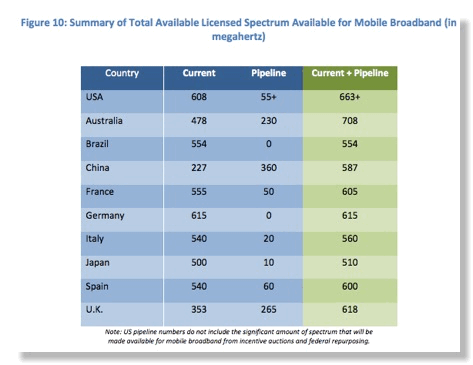
Now why does the current CTIA “flag chart” show the US as having 409.5 MHz of spectrum while the White House finds 608 MHz is a little mystery as neither side shows their raw data. A minor quip: we showed here in March raw data from Japan that added up to 501.2 MHz for Japanese commercial mobile wireless spectrum, yet the White House chart gives 500 MHz, close but not what your blogger documented with detailed data straight from Japan.
Why don’t both the WhiteHouse/FCC/NTIA and CTIA release the raw data that backs up their numerical spectrum claims? This would end the dueling spectrum chart issue so we can focus on substance.
The report also continues to talk about spectrum sharing, a topic that the cellular establishment dismisses in their quest to maximize use of Chinese electronics that meet 3GPP standards. However, most sharing mechanisms involve decision making at the base stations, NOT in the mobiles. So whatever complexity is involved is not int he mobile which is all CMRS architectures are really slaves to the orders they receive from base stations.
Also released was a Presidential Memorandum to Executive Branch agencies on “Expanding America's Leadership in Wireless Innovation”.
This memorandum creates a “Spectrum Policy Team”. The Chief Technology Officer and the Director of the National Economic Council, or their designees, will co-chair a Spectrum Policy Team that shall include representatives from the Office of Management and Budget (OMB), the National Security Staff, and the Council of Economic Advisers. The Spectrum Policy Team will work with NTIA to implement the memorandum and may invite the FCC to provide advice and assistance.
This appears to be the implementation of Recommendation 5.1 of the PCAST spectrum report that was belittled by the cellular establishment because of its sharing recommendations. (Trivia note: the PCAST report recommended a ‘Spectrum Management Team (SMT)” and we see that in the implementation it became a “Spectrum Policy Team”. Not clear if the semantic difference is important.)
Hopefully this means NTIA and IRAC will get more “adult supervision” than they have been getting in the past in order to focus on national priorities, not necessarily the priorities of the individual IRAC member agencies.
The Memorandum also directs NTIA “in consultation with the Spectrum Policy Team” to produce
“a plan directing applicable agencies to provide quantitative assessments of the actual usage of spectrum in those spectrum bands that NTIA previously identified and prioritized in its Third Interim Report and such other bands as NTIA and the Spectrum Policy Team determine have the greatest potential to be shared with nonfederal users.
As mentioned previously, NTIA and the IRAC members have zero interest in quantifying the actual use of 225-400 MHz in urban areas. We hope that the Spectrum Policy Team will include this band as one that should be quantified.
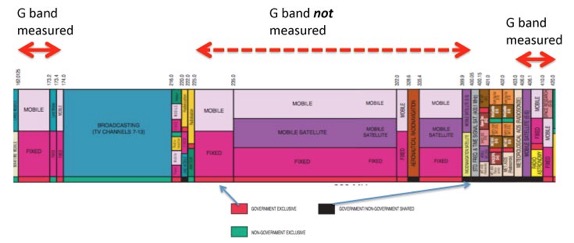
The Memorandum directs NTIA to “conduct a pilot program to monitor spectrum usage in real time in selected communities throughout the country” and “to require that each agency's regular reviews of its frequency assignments include a quantitative assessment of its actual usage of spectrum under such assignments”.
Part of the Memorandum is nonbinding “advice” to FCC, an independent agency:
Performance Criteria for Radio Receivers. The FCC is strongly encouraged, in consultation with NTIA, where appropriate, the industry, and other stakeholders, to develop to the fullest extent of its legal authority a program of performance criteria, ratings, and other measures, including standards, to encourage the design, manufacture, and sale of radio receivers such that emission levels resulting from reasonable use of adjacent spectrum will not endanger the functioning of the receiver or seriously degrade, obstruct, or repeatedly interrupt the operations of the receiver. In developing such a program, the FCC is strongly encouraged to give due consideration to existing policies and prudent investments that have been previously made in systems, including receivers. In its consultation with the FCC, NTIA shall provide information regarding Federal receiver standards and agency practices under those standards.
As previously discussed here, NTIA for over 20 years has been condoning FAA’s unwillingness to implement ICAO receiver immunity standards for ILS receivers that greatly impact FM broadcasting licensees. The hard technical part of receiver standards is creating the standard. But int he case of ILS receiver standards that was done in a multistakeholder process manage by the former CCIR (now ITU-R) and ICAO in the 1990 time frame. But the really hard part is really recognizing the economic externalities involved: in many cases the party that has to buy the improved receiver is not the one who gets the benefit. This is why AOPA vehemently opposes ILS receiver regulation.
NTIA and FAA have been publicly silent on this issue for a long time. “What’s fit for the goose, is fit for the gander.” As part of this reexamination of receiver standards FAA and NTIA should publicly state what they think the issues are with respect to implementation of the ICAO ILS receiver standard and what action, if any, they plan to take.
Finally NTIA and NIST announced plans to establish a National Center for Advanced Communications in Boulder, Colorado. The two agencies recently signed a Memorandum of Understanding (MOU) to collaborate on the establishment of the center. The MOU states that the center will leverage the “critical mass of NIST and NTIA research and engineering capabilities concentrated in Boulder” to form a “unique national asset,” and includes the infrastructure and collaborative environment needed to address a wide range of advanced communications challenges. This joint effort will increase the impact of existing efforts already under way in both agencies.
It is ironic that the present ITS was part of NIST’s predecessor, NBS, until NTIA was created in 1978. ITS, basically a contract research operation for other agencies with little funding of it own, was split from the collocated NBS/NIST in order to give a critical mass to what became NTIA when the last of the Office of Telecommunications Policy was moved out of the White House in Executive Order 12046. This with the creation of the Spectrum Policy Team and the ITS/NIST collaboration a key impact of yesterday’s actions is a move to start to undo the changes of 1978 which in retrospect were not successful.
UPDATE
On this busy day there was conference at Georgetown University entitled “"Optimal Coevolution of Mobile Broadband Technology and Spectrum Policy”. The conference was rather one sided focusing on the concerns of the cellular interests and their usual demands for more spectrum and reallocation vs. sharing. However, several of the speakers discussed the Executive Branch releases of the day. Introduction is below. All videos are here.
UPDATE 2
See http://www.marcus-spectrum.com/Blog/files/SpecMeasCorr414.html
CTIA and NAB's Battling Innovation Websites - I
The blood feud between CTIA and NAB is being expressed now in battling websites, each claiming how innovative their side is. From NAB we have WeAreBroadcasters.com/Innovating and from CTIA we have WirelessisLimitless.org. This is the first of a 2 blog series examining these claims. To be “fair and balanced”, as Fox News would say, we will deal with both sites. CTIA was randomly selected to be first. The following 2 videos are at the top of the CTIA site.
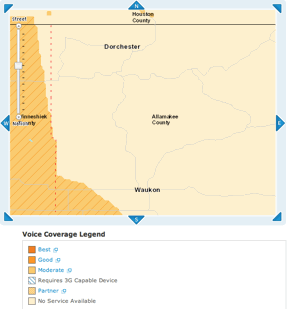
Agriculture is important to the economic fabric of Allamakee County and Iowa. Allamakee County’s 1,032 farms cover 274,844 acres of land, which accounts for 65 percent of the surface land in the county. Crop and livestock production are the visible parts of the agricultural economy, but many related businesses contribute as well by producing, processing and marketing farm and food products. These businesses generate income, employment and economic activity throughout the region.Allamakee County farmers harvested 60,364 acres of corn and 22,008 acres of soybeans, and produced 87,017 hogs and 55,246 head of cattle in 2007. Farms on average are smaller in Allamakee County, at 266 acres, than the statewide average of 311 acres. Sales per farm in Allamakee County were $127,524 in 2007.

Now is spectrum shortage the reason for this lack of cell coverage in these farming areas? A check of the FCC Spectrum Dashboard shows that VZW (dba Cellco Partnership) has licenses in : Fremont, Page, Taylor, Ringold, and Decatur counties in both 700 MHz and the 1700/2100 MHz band, while AT&T (dba AT&T Mobility Spectrum LLC) has licenses in the same 2 bands in Allamakee County where it has no service.
Another odd thing about the videos is the focus in the first one on Smartfield, Inc.’s SmartCrop field monitoring technology. Quite impressive. So we surfed over to the FCC’s equipment authorization site to learn more about this equipment. (Smartfield’s grantee code is “W9B” if you want to check.) Smartfield has 7 FCC equipment authorizations, all of which are for unlicensed Part 15 equipment, the type of thing that CTIA consistently opposes new spectrum for. The video claims that the SmartCrop system uses cellular paths for transmission of data from a central point in the field to Smartfield’s analysis service. So the SmartCrop system appears to be a hybrid unlicensed/cellular service - an inconvenient fact not mentioned in the video.
The second video focus on the wonders of John Deere’s high tech services for farmers. Remember John Deere? These are the people with the irresponsible GPS receiver front end design that covered the GPS band as well as the band above and below it even though it was public knowledge that LightSquared and its predecessors had been given authority to build base stations in the lower band years earlier. The Deere GPS design was easily overloaded by any nearby signal in the adjacent bands and thus was a major cause for the current interest in receiver standards. The CTIA membership did not want LightSquared to compete with them and probably encouraged the John Deere issue as the poster child in the anti-LightSquared campaign to garner political support from farm state members of Congress. So maybe this focus on John Deere could be payback for their anti-LightSquared help.
But if you are a farmer and want to use technology like Smartfield’s or John Deere’s, you really have to have cellular service and the main CTIA members don’t seem to be in a rush to use their existing spectrum to give it to you as they demand more spectrum.
As a sailboat owner, your blogger was impressed with the beauty of the photography in this CTIA video on the Wireless is Limitless site:
Your blogger’s cellular booster antenna
Carrier registration pending
(vertical white rod)
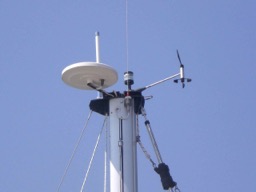
This video describes how the Chesapeake Bay Interpretive Buoy System uses cellular transmission to get real time data on water conditions to fishermen (actually called “watermen” in local parlance) and researchers. But then we recalled that the reason we have a “cellular booster” (fought against so long by the cellular industry in Docket 10-4 and the CTIA 2007 petition) on our boat is that cellular coverage on Chesapeake Bay has real problems. (A cellular industry spectrum specialist acquaintance who also sails - but will not be named here - uses Iridium to keep in touch from his boat.) Let’s look at VZW’s claimed coverage (AT&T’s and T-Mo’s are similar) on Central Chesapeake Bay, the area near Solomons, MD actually shown in the video:
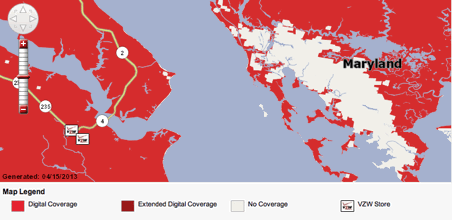
Guess what FCC’s Spectrum Dashboard shows here? Yup, AT&T, T-Mo, and VZW all have multiple licenses in Dorchester County where the white blocks are on all their coverage maps. This is also not a mountainous area.
So whether it is farming in Iowa or maritime coverage on Chesapeake Bay, there are real cellular coverage problems that have nothing to do with spectrum presently available to the cellular industry. As shown above, in these nonmontainous areas there seems to be a lack of interest in the major cellular carriers to finish rolling out their networks. This is good for Iridium and other satellite carriers, but not really good for the public.
The cellular industry certainly needs more spectrum access to keep up with expanding uses that help our society and the economy. But these rural cases are good examples of why spectrum sharing is so important. The real spectrum shortage is in urban areas where civil demand is great and military use small - San Diego being a notable exception. But the demands of the industry for complete reallocations when they can’t even use all the spectrum they have today sound hollow. Why can’t all spectrum users work together to find mutually beneficial solutions to their spectrum problems that don’t depend on cheap Chinese-made equipment. Let’s cool the PR rhetoric and work on real problems.
The review of NAB’s site, also over the top, with be up in a few days.
CTIA Can Be as Rigid as NRA is on Gun Control
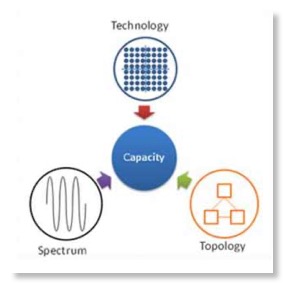
And where will this new spectrum come from? Wireless Week writes
“Largent stressed the need for the FCC, as well as the President, to pressure government agencies like the Department of Defense, to clear unused spectrum for commercial use. ‘It's really hard to pry this spectrum out of their hands...It's incumbent on the president and the FCC to pressure them to give up some of this spectrum’ ”
Largent’s staff then tried to outdo their boss on rigidity.
“Chris Guttman-McCabe, CTIA's vice president of regulatory affairs, made it clear that spectrum sharing is not the end goal, noting that the report from the President's Council of Advisors on Science and Technology (PCAST), which recommended sharing airwaves a matter of policy did not have adequate input from the wireless industry. "There were no infrastructure vendors, no handset vendors at the time and no carriers," Guttman-McCabe said of PCAST. "We believe here, there needs to be a focus on clearing...as a fallback, we are perfectly comfortable investigating sharing...but with the goal of eventually clearing that spectrum."
So PCAST did not have any industry insiders as members. Can you imagine that the White House does not view the techies of the cellular infrastructure vendors, handset vendors and carriers as not meeting their criteria as “the nation’s leading scientists and engineers”.
As a public service, here is an extract from the PCAST report listing the PCAST members and “Invited Experts” involved in drafting it. Isn’t Largent’s predecessor Tom Wheeler there? Now sources tell me that Wheeler really wasn’t very active in drafting the report, but he certainly was in the inner circle. Isn’t Dale Hatfield, my former boss and a close friend of CTIA there also? Note that CTIA proudly posts on it website the following video of Dale saying at a CTIA conference “ we can no longer afford to sacrifice spectrum due to inefficient technology.”

At least Chris is willing to consider sharing as a “fallback”. What if it really works? Will CTIA at least consider that possibility? Is the need for readily available Chinese made equipment in all cellular bands really a key driver in spectrum policy. It is ironic that he says this as Sprint has foresworn Chinese suppliers for the core of their network.
Lest CTIA think that the evil sharing is a concept only advocated by irrational cellular industry enemies at FCC and NAB, perhaps they should review the following document from European regulators:
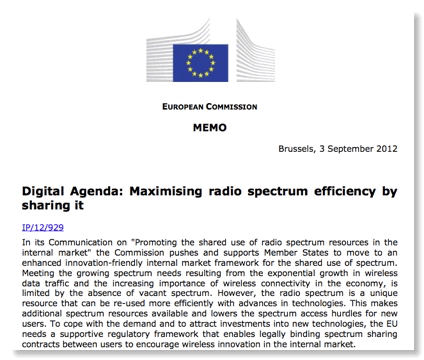
This EC memo has statements like
The radio spectrum is a finite resource – there is no vacant spectrum remaining, and the cost of re-allocating spectrum to new uses is high. On the other hand there is an exponential increase in the use of spectrum – for example driven by mobile computing devices, Wi-Fi hotspots but also smart electricity grids and industrial automation. This creates challenges for meeting the growing demand for spectrum.
However, thanks to advances in technology, it is now possible to share the spectrum more efficiently. Many new wireless technologies are designed to share bands in which no licence is required (licence-exempt bands), while others make additional spectrum resources available by, for example, providing wireless broadband services in between TV frequencies (the 'white spaces'). To maximise the benefits of spectrum sharing, regulatory barriers need to be removed and incentives provided. This requires new regulatory approaches to give different users the right to use a given frequency band on a shared basis...
The main reasons are the economic incentives to use spectrum efficiently by getting more out of the same amount of spectrum wherever technology allows it. The proposed approach is firmly based on the need to provide economic incentives for innovators and incumbents alike..
For example public entities that are incumbent right holders could offer access to spectrum capacity to commercial operators in return for co-funding of network infrastructures, for example for broadband public protection and disaster relief (PPDR) applications. Commercial operators will be able to recoup investment costs by sharing spectrum in areas or at times of the day that their spectrum is underutilised. On the other hand, innovators who can compare sharing opportunities in a competitive internal market could use economic incentives to encourage incumbents to share spectrum, if they have an innovative technology that allows it. In order to reach the economies of scale that stimulate such innovations, the EU needs a common approach in the internal market to identify beneficial sharing opportunities across the entire radio spectrum.
So sharing is not the result of anticellular industry “dark forces” lurking in Washington, it is a concept that is moving faster than the cellular industry wants it to move in order to balance using today’s technology available resources with growing capacity needs while addressing other uses of spectrum that are also valuable to societies and economies.
GigaOM: Is Cisco stacking the deck with its mobile data numbers?
To hear Cisco tell it, the world is quickly running out of wireless spectrum. Tim Farrar, of TMF associates, says a look at the numbers shows that Cisco first overstated them, then revised them, and is now overstating them again.
The Cisco mobile VNI forecast (the shorthand for Visual Networking Index: Global Mobile Data Forecast) is widely used as a justification for specific amounts of new mobile spectrum.
For example on p. 76 of the National Broadband Report it says,
According to Cisco, North American wireless networks carried approximately 17 petabytes per month in 2009,7 an amount of data equivalent to 1,700 Libraries of Congress. By 2014, Cisco projects wireless networks in North America will carry some 740 petabytes per month, a greater than 40-fold increase.
A search on “Cisco” in this report gives 50 uses, although some are duplicates involving their URL.
In a recent FCC filing a few days before the GogaOM post CTIA said
These findings by CTIA bear out the numerous expert projections regarding mobile data traffic:
-Cisco’s Visual Networking Index (“VNI”) projects wireless data traffic in 2016 will be 16 times the volume of traffic in 2011, and 100 times the volume of traffic in 2009.9 This projection involves traffic on licensed spectrum alone, taking into account the off-load of other wireless traffic onto unlicensed spectrum. Thus, Cisco’s VNI projections demonstrate the pressure solely on licensed spectrum.
The GigaOM post points out discrepancies between Cisco’s projections and CTIA’s own reporting of actual traffic:
Nevertheless, at least in the U.S. we can attempt to validate Cisco’s numbers, given that CTIA’s mobile data traffic statistics are based on direct reporting by carriers accounting for 97 percent of wireless connections in the U.S.. In its latest forecast, Cisco estimates that mobile data traffic in the U.S. was 128PB/month in December 2011, and increased to 207PB/month by December 2012.
However, CTIA data indicates that 633PB were carried in the first six months of 2012, for an average of 105.5PB each month. Cisco’s estimate for the U.S. is clearly inconsistent with the CTIA statistics: It is hardly likely that monthly traffic declined significantly between December 2011 and June 2012, and equally implausible that total mobile data traffic in the U.S. then doubled in the second half of the year.
Now spectrum needs are different than traffic projections. Spectrum needs depend critically on infrastructure buildout and technology used. There is not a fixed conversion factor from petabytes to MHz.
A key issue for the cellular industry is which is more cost-effective: acquiring additional spectrum or building out infrastructure to the maximum possible. Of course, acquiring spectrum is a good way to assure long term market hegemony for a given carrier, something mere infrastructure buildout does not assure.
DARPA Starts to Tackle Radar/Comm Sharing
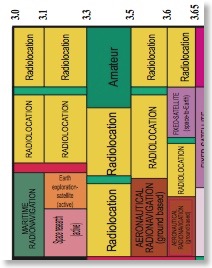
When sharing was proposed, the same IRAC was able to dictate sharing conditions to FCC with the functioning of the radar as originally designed being the paramount issue. Overprotection that limited private sector sharing was of little concern to IRAC and the technical criteria development was often shrouded in secrecy to protect the technical details of the radars involved. This is shown in the case of the 5 GHz U-NII sharing where we have the bizarre sharing conditions of § 15. 407:
According to these 2 sections if an unlicensed device detects any signal on the channel greater than - 64 dBm (non techies: that is less than a millionth of a milliwatt!) it must avoid using that channel for the next 30 minutes! Double checking to see if it is a false alarm due to noise is not allowed by this rule.
§ 15.407(h)(2) Radar Detection Function of Dynamic Frequency Selection (DFS)
A channel that has been flagged as containing a radar system, either by a channel availability check or in-service monitoring, is subject to a non-occupancy period of at least 30 minutes. The non-occupancy period starts at the time when the radar system is detected..Radar Detection Function of Dynamic Frequency Selection (DFS). U-NII devices operating in the 5.25-5.35 GHz and 5.47-5.725 GHz bands shall employ a DFS radar detection mechanism to detect the presence of radar systems and to avoid co-channel operation with radar systems. The minimum DFS detection threshold for devices with a maximum e.i.r.p. of 200 mW to 1 W is −64 dBm. For devices that operate with less than 200 mW e.i.r.p. the minimum detection threshold is −62 dBm. The detection threshold is the received power averaged over 1 microsecond referenced to a 0 dBi antenna. The DFS process shall be required to provide a uniform spreading of the loading over all the available channels…Non-occupancy Period.
A channel that has been flagged as containing a radar system, either by a channel availability check or in-service monitoring, is subject to a non-occupancy period of at least 30 minutes. The non-occupancy period starts at the time when the radar system is detected.
(It is ironic that the recurring interference to NOAA’s TWDR weather radars is not addressed here since TDWR is a doppler system unlike FAA radars. It appears that DoD and FAA dominated the secret IRAC deliberations on the criteria that was dictated to FCC by NTIA and did not pay much attention to NOAA’s radar technology.)
To NTIA’s credit they did choose radar/communications sharing as the theme of the 2011 International Symposium on Advanced Radio Technologies, their annual public technical conference in Boulder CO. The conference was entitled “Developing Forward Thinking Rules and Processes to Fully Exploit Spectrum Resources: An Evaluation of Radar Spectrum Use and Management”. In the proceedings, is a paper (p. 214) from your blogger entitled “Thoughts on Radar/Communications Spectrum Sharing”. This paper breaks from the static precedent of U-NII radar sharing and suggested time dynamic sharing, noting that while 1000 ms/s spectrum access was essential when circuit switched voice dominated mobile traffic, today’s packet switched data is the dominant traffic and packet switching technology can readily make reliable networks our of time intermittent links.
The paper was discussed at the conference and here are two comments from the proceedings:
A second idea that is very important, first advocated for by Michael Marcus, is about unlicensed low power uses and it has spawned a revolution of technological developments that take advantage of that possibility. -- Phil Weiser, U. Colorado (Formerly senior advisor for technology and innovation to the National Economic Council at the White House)
I also wanted to take just a minute to recognize that Mike Marcus, who was originally going to be on this panel but couldn’t make it in the end, also put together a paper that talks about some sophisticated techniques for sharing with radars. -- Julius Knapp, FCC
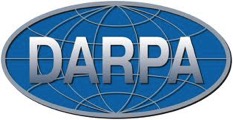
The purpose of this conference is to provide information on the SSPARC program; promote additional discussion on this topic; address questions from potential proposers; provide a forum for potential proposers to present their capabilities for teaming opportunities; and following the conference, conduct pre-scheduled one-on- one meetings with the Program Manager as described below.
PROGRAM OBJECTIVE AND DESCRIPTION: DARPA anticipates releasing the BAA for SSPARC with the objective described in this section. The objective of the SSPARC program is to improve radar and communications capabilities through spectrum sharing. SSPARC develops technology applicable to spectrum sharing between military radars and military communications systems, and between military radars and commercial communications systems. SSPARC includes work on spectrum sharing systems and separation mechanisms, supporting technologies that improve performance when sharing spectrum, theoretical performance limits and grounded design techniques, and relevant regulatory topics.
It is gratifying to see that this concept is moving along towards more detailed study after being ignored for a long time.
Now if only the cellular industry would address the topic of using intermittent access to radar spectrum fro CMRS with an open mind rather than insisting on an unrealistic goal of meeting all their spectrum demands solely by reallocation.
UPDATE
The DARPA BAA is now posted here. From the introduction:
The Shared Spectrum Access for Radar and Communications (SSPARC) program seeks to improve radar and communications capabilities through spectrum sharing.
Spectrum congestion is a growing problem. It increasingly limits operational capabilities due to the increasing deployment and bandwidth of wireless communications, the use of net-centric and unmanned systems, and the need for increased flexibility in radar and communications spectrum to improve performance and to overcome sophisticated countermeasures. Radar and communications jointly consume most of the highly desirable spectrum below 6 GHz. SSPARC seeks to develop sharing technology that enables sufficient spectrum access within this desirable range for radar and communications systems to accomplish their evolving missions.
The SSPARC program seeks to support two types of spectrum sharing.
- Spectrum sharing between military radars and military communications systems (“military/military sharing”) increases both capabilities simultaneously when operating in congested and contested spectral environments.
- Spectrum sharing between military radars and commercial communications systems (“military/commercial sharing”) preserves radar capability while meeting national and international needs for increased commercial communications spectrum, without incurring the high cost of relocating radars to new frequency bands.
UPDATE 2/26/13
Today’s public meeting on the DARPA BAA was a great success with about 150 people present! There clearly is great interest in the topic in the R&D community.
Is there any interest in using such spectrum from the cellular establishment or will they continue their negative reaction to the PCAST report and demand 500 MHz of new spectrum subject to
- nationwide availability
- 24/7 1000 ms/s availability
- compliance with 3GPP band plans?
But as the PCAST report points out this is an unrealistic goal in a country with the largest most information intense military in the world. The cellular industry aimed too high in the “booster amplifier” rulemaking, Docket 10-4. Should they be more reasonable here?
UPDATE 3/15/13
 The SSPARC program now has the logo shown at left. It carefully does not show any physical system in order to be open minded about possible designed. DARPA has now posted on their website presentation from the Proposer’s Day. Of particular interest is a presentation from DoD spectrum managers showing how much spectrum is used by radar today.
The SSPARC program now has the logo shown at left. It carefully does not show any physical system in order to be open minded about possible designed. DARPA has now posted on their website presentation from the Proposer’s Day. Of particular interest is a presentation from DoD spectrum managers showing how much spectrum is used by radar today.GAO Report on Spectrum Sharing
GAO writes,
While federal spectrum users often share spectrum among themselves, they may have little economic incentive to otherwise use spectrum efficiently, including sharing it with nonfederal users. From an economic perspective, when a consumer pays the market price for a good or service and thus cannot get more of it without this expense, the consumer has an incentive to get the most value and efficiency out of the good as possible. If no price is attached to a good—which is essentially the case with federal agencies’ use of spectrum14—the normal market incentive to use the good efficiently may be muted. (p. 11)
Actually while it is true that “federal spectrum users often share spectrum among themselves”, this is mostly due to pressure from Congress and OMB, not so much from NTIA leadership or the collective interest of federal agencies who generally would just like to have their own systems regardless of financial or spectrum efficiency. But the availability of “free spectrum” has warped the decision making process in federal agencies since the marginal cost of spectrum is always less than the marginal cost of more efficient technology.
Echoing the findings of the controversial PCAST report, GAO writes
We have previously reported that to improve spectrum efficiency among federal agencies, Congress may wish to consider evaluating what mechanisms could be adopted to provide better incentives and opportunities for agencies to move toward more efficient use of spectrum, which could free up some spectrum allocated for federal use to be made available for sharing or other purposes.
The report ends with 3 recommendations for FCC NTIA action:
• Report their agencies’ views and conclusions regarding spectrum usage fees to the relevant congressional committees, specifically with respect to the merits, potential effects, and implementation challenges of such a fee structure, and what authority, if any, Congress would need to grant for such a structure to be implemented.
• Based on the findings of current research and development efforts under way, determine how the federal government can best promote federal and nonfederal investment in the research and development of spectrally efficient technologies, and whether additional spectrum is needed for testing new spectrum efficient technologies.
• Evaluate regulatory changes, if any, that can help improve and expedite the spectrum sharing process.
Will this report have a major impact on spectrum sharing? Probably not. But this report adds to the weight of the PCAST report with respect to the problems of federal spectrum management. These problems arise not from the lack of public interest in the NTIA staff and IRAC membership, rather than the fact that the present 1978 NTIA structure is unrealistic in view of the current demands for spectrum from all public and private parts of our society and economy and the new technical options for sharing that just were not even a pipe dream when the 1978 framework was put in place in the Carter Administration.
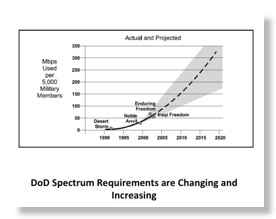

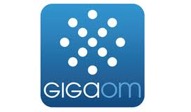
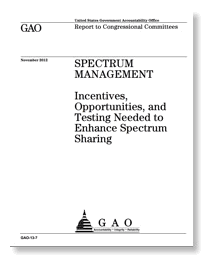



![Validate my RSS feed [Valid RSS]](valid-rss-rogers.png)

